Balanced microbial gut flora to overcome weaning dip
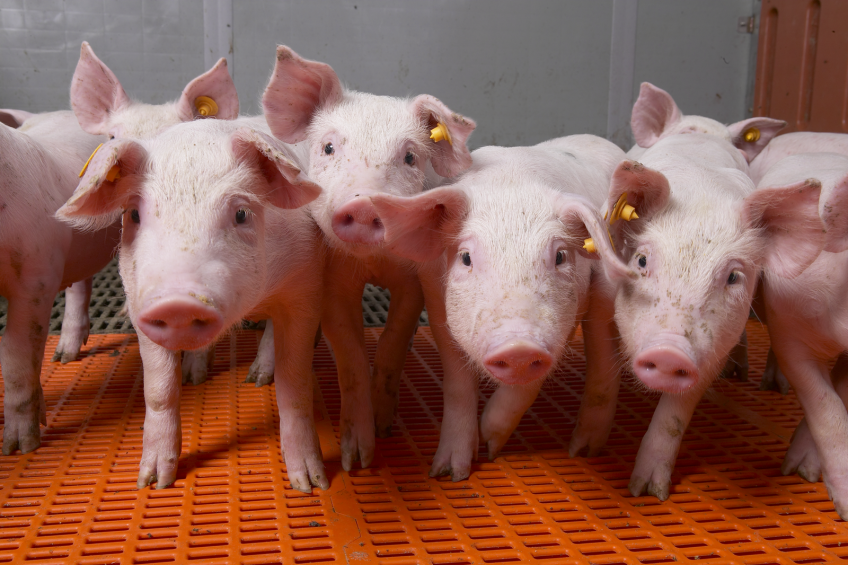
The weaning dip has been well researched and documented. Where piglets used to be treated with prophylactic antibiotics, nowadays other solutions are needed. One of these is a strategy of reducing microbial pressure and enhancing feed intake.
At first, it may sound a bit contradictory – isn’t the weaning dip caused by a (temporary) halt of feed intake? How then, can enhancing feed intake play a key role in a strategy to combat that same weaning dip (see Figure 1)?
Figure 1 – Dry matter feed intake during weaning period.
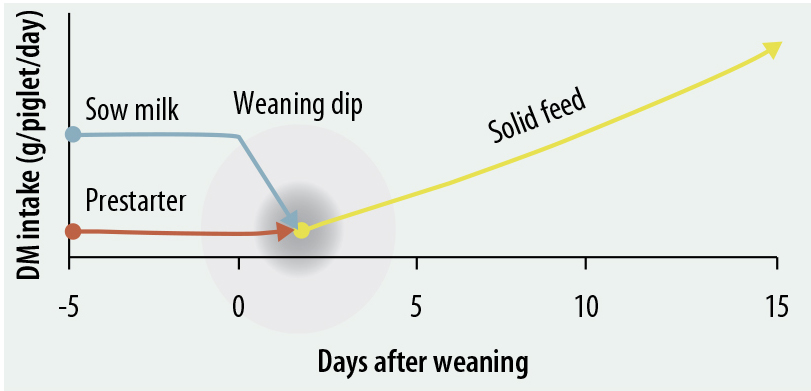
All depends on definition. The weaning dip can also be described as piglets being more vulnerable for pathogens due to a lack of feed intake. The absence of feed in a piglet’s stomach results in a microbial imbalance, leading to higher occurrences of diseases. Thus, this short weaning phase in a pig’s life can have far-reaching consequences, negatively affecting the pig’s entire rearing period.
In the past, antibiotics were prophylactically used to overcome the influence of the microbial imbalances and make piglets less sensitive for potential pathogens. Nowadays, however, there is an increasing pressure of governments in the European Union and beyond, to reduce the prophylactic as well as curative usage of antibiotics in farm animals.
Alternative approaches therefore need to be found, and this is why balancing the microbial gut flora and enhancing feed intake comes into view for feed mills and pork producers these days. One of these includes the addition of medium-chain glycerides and essential oils.
Medium-chain glycerides
Medium-chain fatty acids are known for being able to have an effect on bacteria. Not all medium-chain fatty acids, however, have the same effect, as some bacteria are sensitive to specific chain lengths of fatty acids. Caproic acid for instance, has a relatively strong effect against E. coli and salmonella – more than most other medium-chain fatty acids. In combination with caprylic acid, not only E. coli and salmonella are targeted, but also clostridium.
It has been shown that medium-chain fatty acids have a better microbial regulatory effect, reflected in their lower minimum inhibitory concentration (MIC) values than organic acids. They will target a broader spectrum of bacteria (both gram-positive and gram-negative bacteria). Besides their acidic function, some medium-chain fatty acids, like caproic acid are lipophilic, i.e. that they can dissolve in fats. That way, they can disrupt cell membranes of pathogenic micro-organisms.
Figure 2 – Esterification is needed to form medium-chain glycerides.
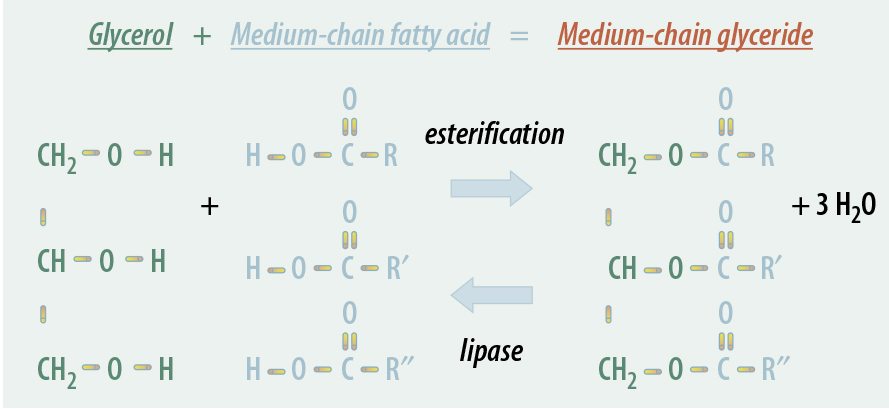
When used in piglet feed, it is important to get the medium-chain fatty acids right there in the digestive system where they will be most effective. By esterifying the medium-chain fatty acids using glycerol they can be linked in a glyceride molecule (see Figure 2). Lipases from the mouth, stomach and gut will work on the esterified medium-chain fatty acids, or medium-chain glycerides, ensuring a gradual release as opposed to free medium-chain fatty acid products. Because of their ‘slow-release’ effect they will be effective in the stomach and continuing on in the digestive tract. The maximum release and effectiveness will be in the small intestine (see Figure 3).
Figure 3 – Release and working spectrum of different strategies in the digestive system.
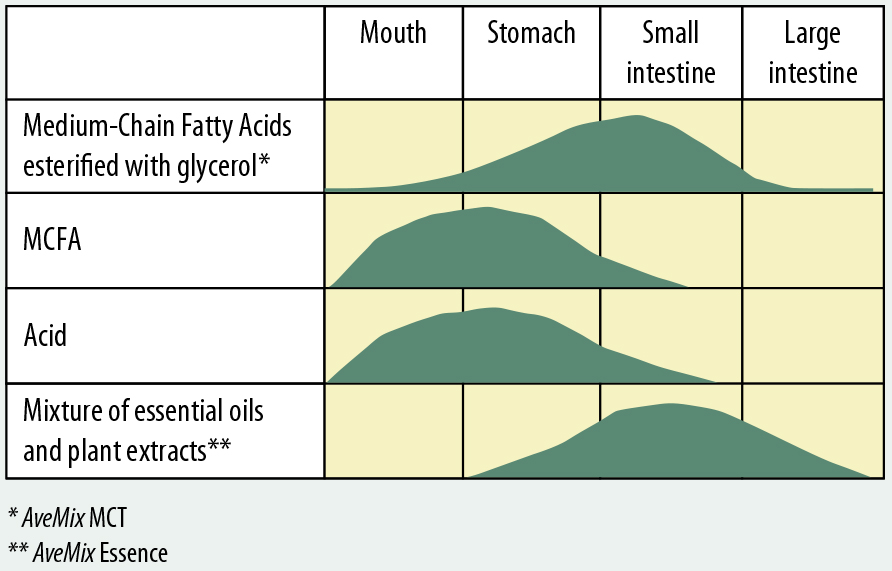
Besides the antimicrobial effect, medium-chain glycerides support the gut health (larger villi and smaller crypt depths; see Figure 4). This positive influence on gut health leads to enhanced uptake and use of nutrients. Medium-chain glycerides are also known to have a positive modulating effect on the immune system. If the immune system is less stressed, it needs less energy and amino acids for its maintenance, which implies that more nutrients become available for the growth of the animal.
Figure 4 – The picture right show the effect of a diet including MCFA with glycerol compared to a control diet (left)

On the basis of extensive research done on medium-chain glycerides, Aveve Biochem developed AveMix MCT. The efficacy of this strategy has been proven in both in vitro and in vivo trials.
Essential oils
Essential oils, made from herbs and spices, have a long tradition as aromas in human food. These phytogenic substances also have a place in medicine and are known for their wholesome effects. Aromatic compounds of oregano, thyme and chili pepper for example, in a phytogenic mixture, have been shown to have a positive influence on several physiological processes in the animal, see Figure 5.
Figure 5 – Different active components of phytogenic blends.

Essential oils are also known to contribute to a balanced microbial gut flora. Extracts stimulating the production of digestive enzymes enhances digestion and absorption of nutrients have been documented. They also have an anti-oxidative function.
The antimicrobial action of phytogenic compounds is twofold.
- Small hydrophobic active components will be absorbed by the cell membrane of pathogenic cells resulting in a higher permeable membrane through which the cell contents will leak out. In reverse, other antimicrobial components of the phytogenic blend will be able to enter the cell. There they will interfere with the bacterial growth.
- The phytogenics can be combined to become antibacterial for both gram-positive as gram-negative bacteria, affecting E. coli, salmonella, clostridia but also eimeria, leading to coccidiosis.
Encapsulating a blend of selected phytogenics in a vegetable fat matrix, Aveve Biochem developed AveMix Essence. This formulation provides stability during the production process. A side-effect is that, just like in the previous paragraph, the matrix will ensure a ‘slow release’ effect throughout the piglet’s digestive tract. In addition, it will remain active at high intestinal pH. It has been shown that addition to piglet feed lowers animal mortality and improves animal performance, like FCR and growth.
Combination
In combination, medium-chain glycerides and phytogenic blends can complement each other – and even be synergistic, i.e. the spectrum of activity is broader than the sum of its parts. Both active components disrupt the cell membrane integrity of pathogenic bacteria through different places of interaction, because of the difference in hydrophobicity, molecule size and charge. The interaction of these molecules will enhance their effect and will provide each other with easier access to the cytoplasm. In addition, lower concentrations are needed.
AveMix Plus combines and augments these ingredients. With its primary goal of balancing the microbial gut flora, a systematic decrease in mortality in production animals has been well documented, as well as an increase in feed intake.
[Source: Pig Progress Special – Piglet Health, 2014]
 Beheer
Beheer

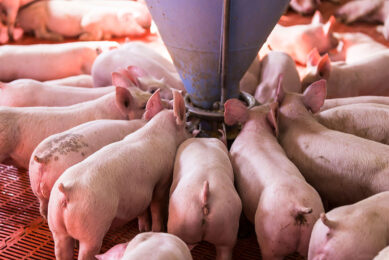
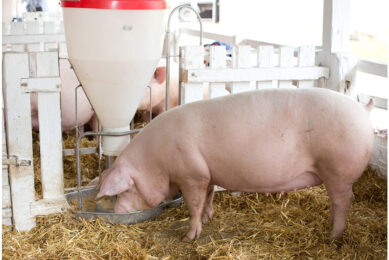
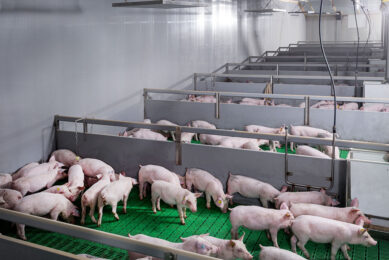
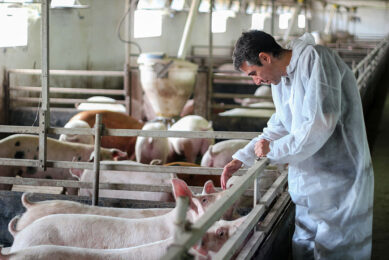



 WP Admin
WP Admin  Bewerk bericht
Bewerk bericht